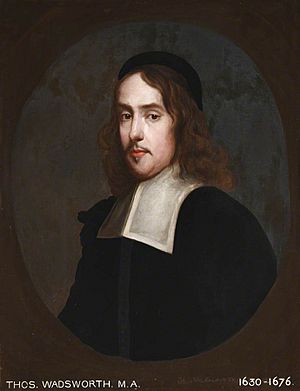Thomas Wadsworth facts for kids
Thomas Wadsworth (born 1630, died 1676) was an important English minister during a time of big changes in England. He was a Presbyterian minister, which means he followed a certain type of Protestant Christian faith. After 1662, he became an "ejected nonconformist." This means he was forced to leave his church because he didn't agree with the new laws about how churches should be run.
Contents
Thomas Wadsworth's Life Story
Early Life and Education
Thomas Wadsworth was born on December 15, 1630, in a part of London called St. Saviour's, Southwark. His father was friends with Samuel Bolton, a well-known scholar and leader at Christ's College, Cambridge University. Because of this connection, Thomas went to Christ's College in 1647. He was a very good student, loved to study, and was deeply religious. He even joined a special club at college where students discussed philosophy and practiced their faith.
Becoming a Minister
After finishing his first degree in 1651, Thomas had to go home because his father was very ill. In 1652, he became a Fellow (a kind of teacher or researcher) at Christ's College. He earned his master's degree in 1654. Following advice from Samuel Bolton, he decided to leave his fellowship and become a minister.
He was asked to lead the church at St. Mary's, Newington Butts, in Surrey. The people in the parish (the church area) really wanted him as their minister. He was officially appointed on February 16, 1653. He became known as a great preacher and teacher, helping people understand their faith.
Challenges and Changes
In 1660, after the English Restoration (when the king returned to power), things changed for ministers like Thomas. The old minister of St. Mary's, James Meggs, wanted his job back. So, Thomas Wadsworth resigned on September 29, 1660.
However, he still had other jobs teaching and preaching. He gave lectures on Saturday mornings at St Antholin's and on Monday evenings at St Margaret, Fish Street Hill. The people of St Laurence Pountney church then asked him to be their minister, and he also taught at St John the Baptist's.
But in 1662, a new law called the Uniformity Act of 1662 came into force. This law said that all ministers had to follow certain rules and ways of worship that many, like Thomas, disagreed with. Because he couldn't agree, he was forced to leave his church. He preached his last sermon there on August 23, 1662, just one day before the law started.
Continuing His Work
After being forced out, Thomas moved to Theobalds in Hertfordshire. He continued to preach privately, both there and to some of his old church members in Newington Butts. He didn't take any money for this work. He kept helping people even during the terrible plague of 1665, a very serious illness that spread through England.
After the Great Fire of London in 1666, he preached in a temporary wooden building in Southwark. He also continued to live and preach at Theobalds. In 1669, it was noted that he was holding a "conventicle" there. This was a secret meeting for worship that was against the law at the time. In 1672, he got a special license under the Royal Declaration of Indulgence, which allowed him to preach as a Presbyterian teacher in a private home.
A few weeks before he died, Thomas moved back to Southwark. He passed away on Sunday, October 29, 1676. His friend, Robert Bragge, gave the sermon at his funeral. Another famous minister, Richard Baxter, took over Thomas's congregation for a while.
Thomas Wadsworth's Writings
Thomas Wadsworth wrote several books and sermons. Here are some of them:
- Ἀντιψυχοφαναία, or the Immortality of the Soul (1670): This book was about the idea that the soul lives forever.
- Faith's Triumphs over the Fears of Death (1670): This book talked about how faith can help people overcome their fear of dying.
- Separation yet no Schism (1675): This writing discussed why his group, though separate from the main church, was not causing a harmful split.
- Last Warning to secure Sinners (1677): These were his last two sermons, published after his death.
- Meditations on the Lord's Supper (1680): This book contained his thoughts on the Christian ceremony of the Lord's Supper.
- Remains: A collection of his writings, which also included a story about his life and a picture of him.
- Self-Examination (1687): This book encouraged people to think deeply about their own lives and faith.
Thomas Wadsworth's Family
Thomas Wadsworth was married three times. His first wife was the younger daughter of Henry Hasting. She sadly died in 1661. In 1663, he married Margaret, who was the daughter of Henry Gibs and a widow. She passed away in 1668. In 1671, he married Anna, the only daughter of Colonel Markham. With Anna, he had two sons (one of whom died when he was a baby) and two daughters. He did not have any children who survived from his first two marriages.


